 Written by Megan Smith, PT
Written by Megan Smith, PT
Children on the autism spectrum can find it difficult to express themselves. This can bring about overwhelming frustration and anger that can lead to a tantrum or full-blown crisis situation. The best strategy for de-escalating a potential meltdown is to anticipate possible events or triggers and head off a tantrum before it begins.
Sleep is so important to the regulation of the nervous system, but sleep issues can plague kids with special needs. Tools and techniques to help them relax before bed at night can make the days much better. Strategies and relaxation techniques should include the use of sensory calming toys, which are valuable tools to help a child self-regulate.
Consider what activities your child needs assistance with, actively seeks out, or actively avoids.
Look for behavior patterns that will illustrate what sensory system or systems need the most attention.
If your child shows certain sensory needs at certain times of the day, get toys that can be a part of the environment wherever the child routinely is at that time.
These products help kids engage movement, sight, smell, hearing, touch, and taste. Sensory toys help kids take in the sensory inputs to relax, balance the nervous system, and overcome anxiety to find calm via physical and mental stimulation.
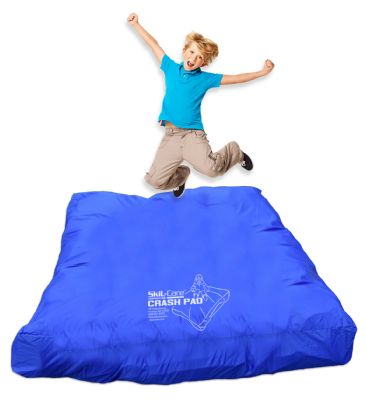 | 1) Skil-Care Sensory Integration Crash Pads View Product |
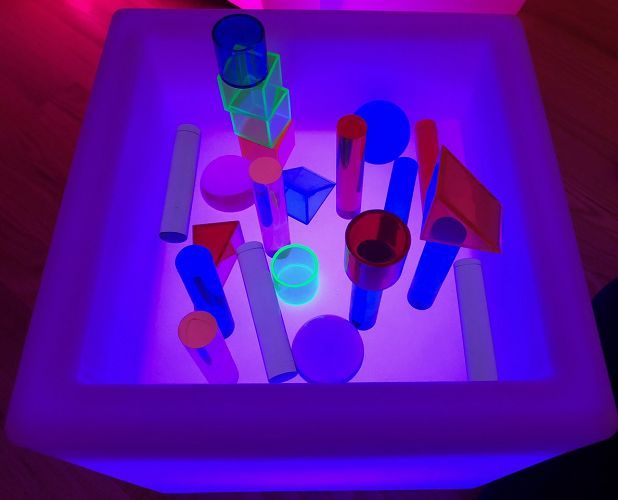
Entering our list of best sensory calming products at number 5 is the Water and Sand Play Light Cube for Sensory and Motor Development by Rover Education. This cube is an engaging learning tool that also promotes relaxation.
Durable and waterproof, it can be filled with water or sand to challenge kids to identify, count, sort, and group objects while they develop fine motor skills. In addition to learning about how light can affect colors and objects, kids also relax in the soothing atmosphere the cube’s lighting creates. It’s popular with teachers and therapists because it does double-duty. The action keeps kids interested in learning, and the chromotherapy (color light therapy) calms the nervous system of sensory seekers.
The cube, which can stand up to wear and tear at the hands of high-energy kids and is appropriate for indoor or outdoor use, comes in your choice of two sizes and has a remote control that regulates the LED lights. It’s lightweight and portable so you aren’t limited where you can provide learning and relaxing experiences.
This unique cube made our list because of its versatility and its appeal to all children. It can be enjoyed by any kid, so children who benefit from sensory calming devices aren’t separated from their peers. It delivers multiple benefits, adding to its versatility as a tool for learning, developing fine motor skills, and calming the nervous system.
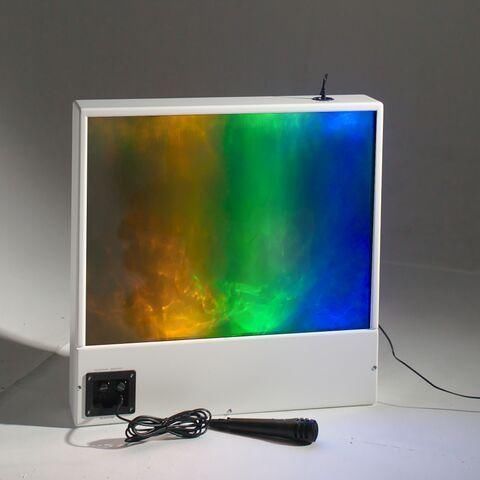
At number 4 on our list is the Sound and Light Visual Stimulation Panel by TFH. Not just for kids with special needs, this toy encourages talking, singing, and exploring sound in a fun way that engages users of all abilities.
The microphone transmits sounds to the panel, and the lighting effects are affected by the pitch of those sounds. The colors correlate to the sounds, with lower pitched sounds creating a red glow, mid-pitch sounds glowing orange, yellow, and green, and blue and purple lighting up for the highest pitched sounds. The brightness is determined by the volume of the sound.
Activated by music or voice, the sound sensitivity of the microphone can be controlled. It is designed to encourage vocalizing and cultivating decision-making skills, since the user can directly influence the brightness of the light panel by the volume of the sound being produced.
For kids with sensory processing disorder who seek auditory or visual stimulation, this sound and light panel is a great tool for self-regulation and calming of the nervous system. It can be wall mounted or freestanding, which makes it easy to move, and as an end-of-the day activity can help kids relax before bed.
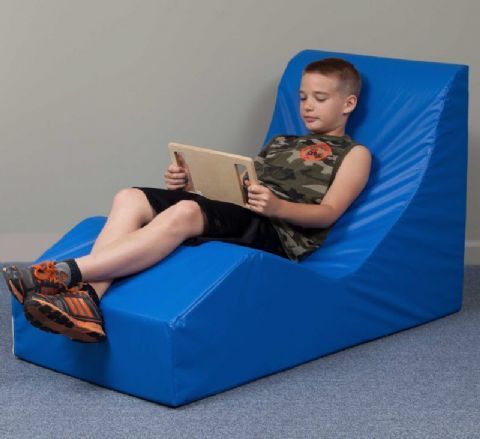
Because of the way it distributes body weight and promotes relaxation, the Relaxer Positioning Chair by TFH is our sensory calming number 3 choice.
There are multiple versions of this chair. The Junior Relaxer sits on the floor and is easy for kids to get on and off and is the perfect spot to destress and decompress alone. With room for two, the Double Relaxer encourages socialization and connection as well as relaxation. There is a full-size Raised Relaxer that is shaped with the perfect contour for kids and adults to enjoy. It sits higher off the ground and comes with a hook-and-loop strap for safety.
An optional Relaxer Base can be ordered for the Standard Relaxer, raising it 13 inches and making it easier for anyone with a larger frame to move on and off.
Promoting proper posture and spine alignment, this comfortable chair provides even support to relax body tension with the benefit of full-body contact to calm the tactile sensory system. The design makes this chair great for activities like watching tv or reading, or just sitting back and relaxing. It’s easy to clean and there is a model suitable for every member of the family.
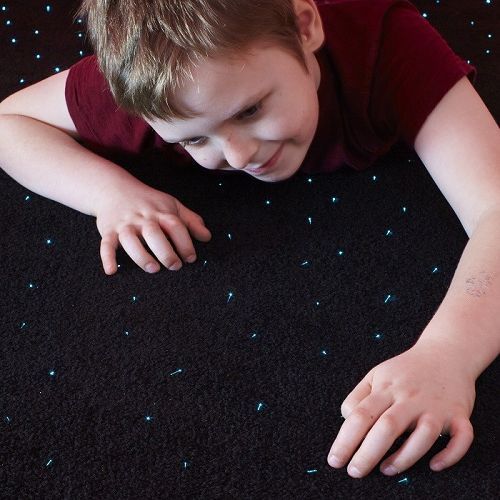
With three models to choose from, the time-tested Color-Changing Fiber Optic Sensory Chromotherapy Carpet by Experia USA is number 2 on our list. This star-themed carpet engages children with hundreds of tiny color-changing lights to serve their visual sensory systems.
The Calming Model’s LED lights change colors slowly, creating a calming environment to facilitate de-escalation in times of stress. It provides a safe and soothing space so a child can relax. It’s a great place to spend a little time before bed.
The 8-way wireless controller of the Superactive Model governs the sensory environment to reinforce motor control, cause and effect, color recognition, and other learned skills. The wirelessly rechargeable controller doesn’t have to be within reach, as it can be operated from up to 90 feet away.
The IRiS version can be paired with other controllers in the product line to develop deeply personalized experiences in support of multisensory stimulation and learning.
Each of these fiber optic carpets are handmade using the latest in LED technology, ensuring their brightly colored lights are vibrant and impactful. Measuring 39 ½” x 78 ¾”, no matter what sensory input they provide, each of these models can be counted on to deliver chromotherapy comfortably and safely.
Universality is a huge plus when it comes to sensory aids - the number one choice on our list, Sensory Integration Crash Pad by Skil-Care, is a great example. Readymade for a wide number of use cases, including jumping, climbing, sitting, resting, and balance practice, the Crash Pad truly offers something for everyone by promoting coordination, relaxation, and play all at once.
The Crash Pad works well in all sorts of multisensory environments due to its elegant simplicity and variety of practical applications. Filled with foam and covered with a rip-stop nylon surface, the Crash Pad is both soft and sturdy, requiring minimal maintenance or supervision even over prolonged periods of use. In fact, the nylon material is easy to clean using household wipes and disinfectants, a useful feature when dealing with small children.
Whether your child is energetic and in need of an outlet for their physical inputs or just needs a private place to relax, the Crash Pad can be set on the floor or leaned against the wall of any room, perfectly accessible and easy to utilize.
If needed, a machine-washable cover is available for added safety and cleanability, preventing children from easily accessing the foam inside the pad. The Crash Pad is available in two sizes, depending on the size of the room where it will be used and kids who will be using it.
The Crash Pad’s proprioceptive feedback gives it a wide variety of functions, making it easy for us to recommend at the number one spot on our list. The soft pad gives kids with special needs a multi-purpose device to accommodate their diverse behaviors, allowing them to act in a way that feels natural and fosters joy and personal growth.
Kids with autism and sensory processing disorders are not always understood, which increases stress and anxiety, and the accompanying reactions. Also, their busy nervous systems need rest. These sensory calming toys and tools use visual stimulation, audio stimulation, and tactile stimulation delivered in different ways to help kids relax before bed and de-escalate if a tantrum or meltdown is on the horizon. Any of them will serve kids well delivering the right stimulation to induce a feeling of calm and relaxation.
Effective relaxation skills prevent the nervous system from launching into panic mode. When this process is interrupted, the nervous system can be directed from anxiety to calmness. Relaxation techniques can be focused on the mind, the body, or both.
Belly breathing reverses the anxiety-inducing process that speeds up shallow breathing. Taking slow, deep breaths from the diaphragm expand the lungs, circulating more oxygen and disrupting the panic response.
In Progressive Muscle Relaxation (PMR), the various muscle groups are tensed and then relaxed, which helps reverse the muscle tension that can be brought on by distress.
Relaxing Imagery is a way to counter the disturbing mental images that can cause or worsen anxiety in stressful situations. Replacing those images with pleasant ones in the mind will counter the scary images and calm the stress response.
Children on the autism spectrum can benefit from the same relaxation techniques that work with any other kid. Some slight modifications in how the above relaxation skills are taught can engage and motivate children with autism and equip them with the ability to better self-regulate.
Kids on the spectrum want to know why they are being taught something. Participation can be fostered by explaining, in age-appropriate terms, the nervous system’s stress response and the way relaxation techniques work.
Most autistic children are visual learners. Through visual aids like drawings, videos, and charts, kids can learn about the body’s stress reaction and accompanying relaxation techniques to counter anxiety.
Accurate and plain language works best, without metaphorical references. For example, “your lungs should fill up with air like a balloon” is better than, “feel the energy.”
Transitions, sensory sensitivities, language processing, social anxiety, and frustration from being misunderstood can create a stressful environment. Understanding that kids on the spectrum are facing extra doses of anxiety can help design a support plan that includes relaxation techniques.
Emphasis how and when to use a relaxation technique. This will not happen spontaneously or naturally. Specific examples and clear direction need to be taught and reinforced from teachers and caregivers.
With sensory processing disorder, the brain has trouble receiving and responding appropriately to information taken in through the senses, making someone with SPD more sensitive than other people are to sense-related stimulation.

Megan has been a part of Rehabmart since its inception nearly 20 years ago. For the past several years she has been enjoying her role as HR Director while maintaining her Physical Therapy license. When she isn't working on her next in-service or working to find a new team member, she enjoys her five children, helping those who have PT type ailments, baking, practicing yoga, and working out.